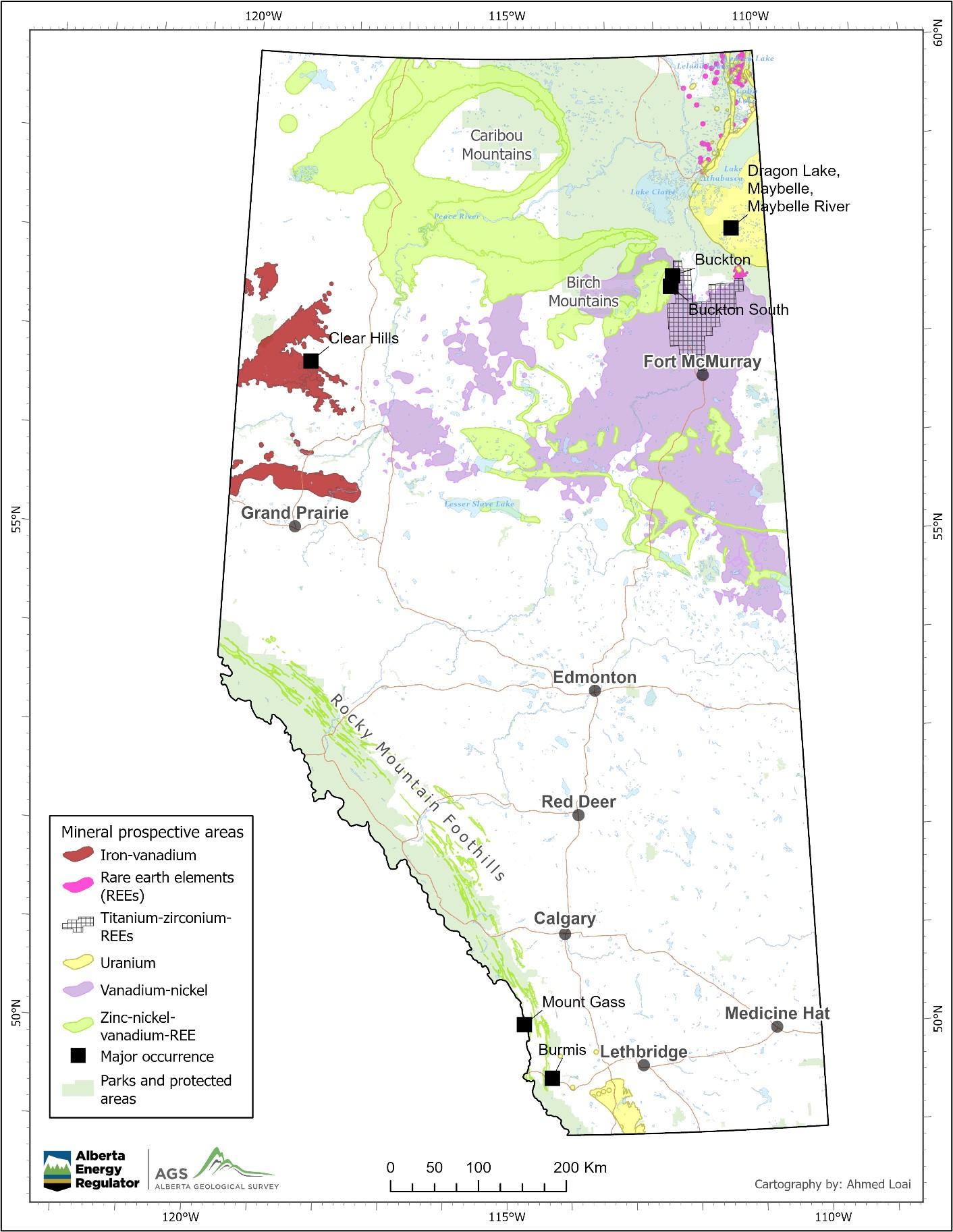Updated June 2025
Introduction
Alberta has a wide variety of critical mineral occurrences and several deposits. While significant recent work has been done on evaluating brine-hosted lithium resources and assessing their economic potential, ten additional mineral commodities from Canada’s critical minerals list are currently deemed to have moderate to high prospectivity in Alberta (INF 156). The following commodities are presented because of their near-term prospectivity: uranium, vanadium, rare- earth elements, iron, and zinc. The map below highlights major occurrences and zones of prospectivity.
The map below shows selected major occurrences and prospective areas of Alberta for uranium, vanadium, rare earth elements, iron, and zinc. Polygons for prospective areas are under final review and are expected to be published on the AGS website and will replace Map 590. Additional mineral occurrences are available in the Alberta Interactive Minerals Map and mineral occurrence lists (DIG 2019-0026).

Uranium
Because of its energy density and fission properties, uranium is primarily used for nuclear power applications but has some additional military applications. Uranium occurs in three main deposit types in Alberta: unconformity-related uranium, sandstone-hosted uranium, and intrusion-hosted uranium. Like the world-class uranium deposits in Saskatchewan, Alberta hosts an unconformity-related uranium prospect in the Athabasca Basin of northeastern Alberta called the Dragon Lake/Maybelle River uranium project. In addition, low-grade sandstone-hosted uranium has been identified in southwestern Alberta. In northeastern Alberta, pegmatite and granitoid intrusions exhibit low- to moderate-grade uranium associated with rare-earth elements.
The Alberta Geological Survey (AGS) has published reports investigating the potential of unconformity-related uranium in northeastern Alberta (OFR 2009-19), sandstone-hosted uranium in southern Alberta (e.g., ESR 2007-10), and intrusion-hosted uranium in the northeast (OFR 2010-08). Additional investigation and preparation of a uranium commodity summary are ongoing at the AGS.
Vanadium
Vanadium is used primarily in steel alloys, though emerging technologies such as vanadium redox batteries have been increasingly studied for long-term energy storage. The most promising vanadium sources in Alberta are oil sands waste, the Rambling Creek/Clear Hills ironstone deposit, and the Birch Mountains metal-rich black shale deposit (INF 155). Recent estimates, based on 2017 production values, suggest that between 34 000 and 39 000 tonnes of vanadium are concentrated through oil sands and in situ bitumen processing each year in Alberta (SPE 113). The AGS is currently collecting and compiling data on oil sands and their associated wastes to enhance public understanding of the distribution of vanadium and other critical elements in these geological and industrial waste materials.
Rare-earth Elements
Rare-earth elements are a group of elements that have a wide range of uses, including catalysts, ceramics, phosphors, strong magnets, alloys, and lasers. In Alberta, elevated concentrations of rare-earth elements have been identified in the Birch Mountains metal-rich black shales, pegmatites and granitoids of the Canadian Shield, sedimentary phosphate-bearing rocks of southwestern Alberta, oil sands froth treatment tailings, and coal fly ash. The AGS continues to investigate these rare-earth sources.
Iron
Iron is used primarily in steel production and represents one of the most important industrial commodities. Globally, iron is produced primarily from banded iron formations and mafic intrusive complexes. In Alberta, various iron occurrences have been identified, including the Rambling Creek/Clear Hills iron deposit in west-central Alberta (e.g., GEO 05-0205, OFR 2009-01) and the Burmis paleoplacer magnetite occurrences in southwestern Alberta (BUL-009).
Zinc
Zinc is used primarily as a galvanizing agent and in brass alloys due to its reactive properties. In Alberta, zinc has been identified in the Birch Mountains metal-rich black shale deposit and in numerous metal-rich black shales throughout Alberta (SPE 009; Eccles et al., 2013). Significant zinc concentrations have been recorded in the Oldman occurrence at Mount Gass in southwestern Alberta. The AGS has published several reports on these metal-rich black shales (SPE 009) and on the Oldman occurrence (OFR 1973-25 and OFR 1985-08).


